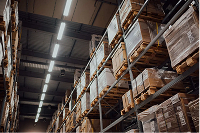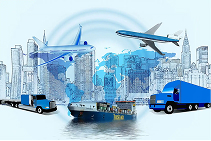E-commerce Inventory Management: A Step-By-Step Guide
E-commerce inventory management is a complex process, but we’ve simplified it for you.

When you travel on vacation, it’s natural that you look for the best mode of transport to save time and money. In e-commerce transit, the same mentality applies.
E-tailers have always wanted to streamline the ways their goods are transported from one place to another, but many of them stop at the thought of having to compare the numerous transit methods available.
To simplify things for you, this article examines the pros and cons of four common e-commerce transit options. We’ll also look into some e-commerce transit trends and challenges to help you stay on top of the game in the e-commerce space. Let’s get started!
E-commerce transit options
When it comes to transport of goods, there are four major options: trucks, trains, ships and planes. They fall into the categories of road, rail, maritime and air transportation respectively.
In this section, we’ll examine the pros and cons of each of these e-commerce transit options, so you can decide which is best for your online business.
Road transportation refers to the transit of goods on roads, usually in trucks. This type of transportation is traceable, low-cost and rather flexible, but has limited capacity and is prone to accidents and delays.
Following, the pros and cons of trucking will be examined in detail.

Trains are known for their reliability, eco-friendliness and high load capacity. However, they aren’t always accessible (e.g. in remote areas) and have rigid routes and schedules.
Below is a list of benefits and drawbacks of trains as an e-commerce transit method.

Ships are best for their unmatched capacity, safety and affordability. Yet, there’s one fatal drawback with this e-commerce transit method that may agitate your customers.
Read on to learn about the pros and cons of ocean freight.

Air transport promises speed and reliability, but there is (literally) a price to pay. Here are the pros and cons should you wish to find out more.

Road, rail, ocean and air freight are four transit options that have been around for decades. Understanding their advantages and disadvantages will, no doubt, help you make the call on how your goods should be moved around.
Yet, as we sail into the uncharted waters of e-commerce in a dynamic world, new challenges lay ahead and e-tailers must be well aware of them. Here’s what you need to know.
If the years-long Covid-19 outbreak has taught us anything, it’s to expect the unexpected.
Fuel price volatility, equipment shortages and labor scarcity are but some challenges faced by the transport and logistics (T&L) industry — which serves millions of e-commerce businesses worldwide — and there are certainly more to come.
In these difficult times, winning e-tailers are able to quickly adapt to changes in the macro environment. This is how they survive and thrive against the headwinds.
For instance, diversification of the carrier mix proves to be an effective solution for e-commerce sellers to minimize the impact of logistical disruptions.
While the long-haul trucking sector was plagued by consistently high driver turnover rates, and activities on the sea were constrained by the shortage of shipping containers due to border closures, railroads became the go-to option for e-commerce transit amid the pandemic.
And that’s why the railway industry saw increased activity when its road and ocean counterparts suffered blows in unprecedented ways.
Going forward, multi-modal transportation is here to stay.
At the best of the times, a strong mix of transit methods helps e-commerce sellers maintain robust and efficient supply chains (e.g. sea freight for import and road transport for last-mile delivery); and in times of crisis, they will guard you against disruptions in certain industries.
Importing goods from overseas is nothing new, but cross-border e-commerce – which entails shipping to global customers – is the next big thing to watch for.
In fact, 76% of online shoppers today have made purchases on site outside of their home regions, with the top reasons being better prices, access to products unavailable locally and discovery of new items.
On the issue of cross-border online shopping, one report revealed an interesting trend: consumers from regions with high living costs (e.g. France and Singapore) tend to buy from China and other regions in Southeast Asia, where production costs (hence product prices) are comparatively lower.

Whether you like it or not, the era of borderless commerce is here.
To successfully ride this wave of opportunity, e-tailers must be prepared to tackle the wealth of challenges of cross-border e-commerce logistics — costs, speed, compliance and many others — or you’re bound to lose the war.
Applied in the right way, technology can tackle many recurrent problems faced by e-commerce businesses.
For example, artificial intelligence now assists with routing vehicles and optimizing drop-off routes, Elon Musk from Tesla is pushing for self-driving cars, and Amazon has plans to use drones for package delivery.
These are technologies in action that have profound implications on how e-commerce transit works in the future.
By automating tasks that were laborious to complete, businesses will be able to reduce their dependence on human workers significantly. The result? Increased efficiency, lower costs and higher speed it is.
In the past decade, the world has seen a catastrophic pandemic, the cross-border e-commerce boom and innovative technologies that will transform our lives and future. Each of these might never have been envisioned before, but now they’re right here before our eyes.
At Choco Up, we transform the e-commerce funding experience in ways you may never have imagined before.
Without lengthy application forms to fill, it’s quick and painless. We ask not for fixed repayments in rigid schedules, but only a small percentage of your revenue until the sum is paid off. And in case you’re wondering, we don’t take any equity from you.
Whether you’re a digital merchant looking to invest in advertising or inventory, or are planning product or market expansion, we can lend a helping hand. Learn more about our client success stories or apply for funding now!
Grow your business with Choco Up

E-commerce inventory management is a complex process, but we’ve simplified it for you.

While there’s no surefire formula to acing the e-commerce logistics race, we’ve found some proven strategies that work.